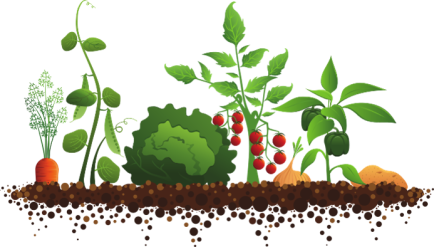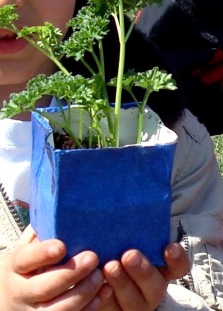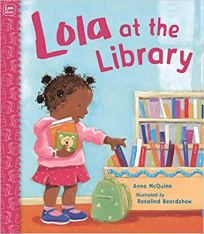
Spring has sprung! Gardening and time spent outside in nature provides endless opportunities to dig into the five early literacy practices: talk, sing, read, write, and play!
Nature Walk
Go for a nature walk in your neighborhood and talk about what you see and hear. Can you find some treasures on your walk? Do you see any interesting sticks, leaves, seed pods, etc? Watch the video below to see what Miss Linda found on her nature walk. She has a fun craft idea using what you found on your walk!
Click here for Miss Linda’s Nature Walk Craft Time
Recycled Gardens
 Don’t have a backyard for garden play? Let’s get creative! Cut the top off of a milk or juice carton. Poke holes in the bottom for water drainage. You can also use plastic milk jugs, egg cartons, or other recycled containers.
Don’t have a backyard for garden play? Let’s get creative! Cut the top off of a milk or juice carton. Poke holes in the bottom for water drainage. You can also use plastic milk jugs, egg cartons, or other recycled containers.
Allow your child to decorate their recyclables any way they would like! Provide a variety of materials – paint, crayons, glue, sequins, etc. There is no right way, so allow your child to use their imaginations! Decorate your own container alongside your child and talk about what materials each of you are using to decorate your container. The process of decorating their container is also great for developing your child’s fine motor skills and strengthening the hand muscles they will need to write!
Allow your child to scoop potting soil into the containers. Help your child to plant seeds or place transplants into the containers. Talk with your child about their garden.
- What seeds should we plant?
- Show your child seed packets or plant tags and point to the words on the packet as you read them. This demonstrates that printed words have meaning.
- How tall will your plant grow? (Could we measure it with a ruler?)
- Is this a plant that will produce flowers?
- Will vegetables or fruit grow on your plant?
Nature Soup
Outside, fill a bucket or large bowl with water. Add a large spoon or ladle and some small bowls for serving. Ask your child what should go into your soup. Should we add some of the things we found on our nature walk? Should we pick some dandelions, grass, or flower petals? Let your child guide the play, but play along with your child and talk about what they choose to add to the soup.
Garden Songs
While you’re working in the garden, painting your container garden, or going for a nature walk, sing these garden songs!
The Gardener Plants the Seeds
(Tune: “The Farmer in the Dell”)
The gardener plants the seeds
The gardener plants the seeds
High ho the derry oh, the gardener
plants the seeds.
(You can also replace “The gardener” with your child’s name!)
Other Verses:
The rain begins to fall
The sun comes out to shine
The seeds begin to grow
There’s Something in My Garden
There’s something in my garden
Now what can it be?
There’s something in my garden
That I really can’t see
Hear its funny sound
RIBBIT RIBBIT RIBBIT
A frog is what I found!
RIBBIT RIBBIT RIBBIT
More Animals:
Mouse – SQUEAK SQUEAK SQUEAK
Bird – TWEET TWEET TWEET
Rabbit – THUMP THUMP THUMP
Snake – SSS SSS SSS
Gardening eBooks
Though the library is closed right now, you can still incorporate ebooks into your gardening activities!
Hoopla 
Visit the Library’s downloadable resources on our website to access Hoopla!
- Badger’s Perfect Garden (by Marsha Diane Arnold)
- Up in the Garden and Down in the Dirt (by Kate Messner)
- Plants Can’t Sit Still (by Rebecca E. Hirsch)
- From Seed to Sunflower (by Mari Schuh)
- Gardens in Spring (by Jenny Fretland VanVoorst)
Storyline Online
 The SAG-AFTRA Foundation’s award-winning children’s literacy website, Storyline Online, streams videos featuring celebrated actors reading children’s books alongside creatively produced illustrations.
The SAG-AFTRA Foundation’s award-winning children’s literacy website, Storyline Online, streams videos featuring celebrated actors reading children’s books alongside creatively produced illustrations.
Bees are important in our gardens! Read Please Please the Bees with Rasida Jones, written and Illustrated Gerald Kelley, to learn how bear can help the bees in his yard!
Gro-Town
Gro-Town teaches preschoolers and toddlers the wonder and magic of the world around us. Learn about music, gardening, and community with each Gro-Town video. Real, fun, live action music videos you can feel good about!
Also be sure to check out the album Motown is Gro-Town and download your own garden journal at www.gro-town.com.
Get out outside today and enjoy talking, singing, reading, writing, and playing in nature!
Miss Emily – Early Literacy Librarian





 Book! Book! Book! by Deborah Bruss
Maisy Goes to the Library by Lucy Cousins
Library Lion by Michelle Knudsen
Lola at the Library by Anna McQuinn
Madeline Finn and the Library Dog by Lisa Papp
Curious George Visits the Library by H.A. Rey
Froggy Goes to the Library by Jonathan London
Library Day by Anne Rockwell
Dinosaur vs. the Library by Bob Shea
Book! Book! Book! by Deborah Bruss
Maisy Goes to the Library by Lucy Cousins
Library Lion by Michelle Knudsen
Lola at the Library by Anna McQuinn
Madeline Finn and the Library Dog by Lisa Papp
Curious George Visits the Library by H.A. Rey
Froggy Goes to the Library by Jonathan London
Library Day by Anne Rockwell
Dinosaur vs. the Library by Bob Shea